Evaluating the Comprehensive Benefit of Group-Affiliated New Energy Power Generation Enterprises for Sustainability: Based on a Combined Technique of STBI and TOPSIS
Abstract
:1. Introduction
2. Literature Review
- (1)
- From the literature review, it can be found that current studies are mainly conducted from an external perspective. For all we know, this is the first study that performs the benefit evaluation on group-affiliated new energy power generation enterprises from an internal perspective of group management and control.
- (2)
- As noted above, benefit evaluation of group-affiliated new energy power generation enterprises requires the consideration of blended evaluation information of multi-source and multi-form. Although the technique for order preference by similar to ideal solution (TOPSIS) has been applied to deal with CE problems in many fields, it is still confined to a single or finite evaluation information form(s), while the stochastic transformation for blended information (STBI) has been proved good performance in such problems. To the best of our knowledge, this is a novel hybrid CE technique combining STBI and TOPSIS for benefit evaluation of group-affiliated new energy power generation enterprises. This attempt upgrades the TOPSIS method with STBI, which can cope with the blended information and additionally, extent the application domain of TOPSIS.
- (3)
- The basic link of STBI is to generate random numbers characterized by a probability among the numerical intervals corresponding to the original evaluation information, which can preserve the original evaluation information to the utmost and avoid information loss during the transformation. At the same time, TOPSIS can also make full use of the existing information [32]. Therefore, the hybrid technique of STBI and TOPSIS can deal with the CE problems with complex and blended evaluation information efficiently and overcome a major shortcoming of existing approaches that lose or distort the original preference information in the calculating process, which can also be applied to many other fields.
3. Comprehensive Benefit Evaluation Indicator System of Group-Affiliated New Energy Power Generation Enterprises
3.1. Economic Benefit
- (1)
- Power generation capacity (X11): refers to annual total generation capacity of an affiliated enterprise. Owning to different regional governments subsidies, all affiliated enterprises may differ greatly in feed-in tariffs from one to another. Therefore, this indicator can reflect the prime operating revenue of the affiliated enterprises more accurately than the prime operating revenue itself, which is the basis of source of income for the new energy power generation enterprises.
- (2)
- Growth rate of power generation capacity (X12): refers to the year-on-year growth rate of power generation capacity for each affiliated enterprise, which can not only reflect the progressing speed of their main business (i.e. new energy power generation) but also be a predictor of the sustainable development ability of economic benefit of each affiliated enterprise.
- (3)
- Total profit (X13): is a comprehensive economic indicator to evaluate the economic benefit of each affiliated enterprise, which can represent the operating result of the affiliated enterprises within an accounting year.
- (4)
- Growth rate of total profit (X14): refers to the year-on-year growth rate of total profit made by each affiliated enterprise. This indicator is also a measure of development speed and ability of the affiliated enterprise but more in an economic way.
3.2. Operation Quality
- (1)
- Cost control (X21): refers to the ability of an affiliated enterprise to cut down its overall costs including newly-built projects costs, production costs, operational maintenance costs, administrative costs, labor costs and so on, by comprehensive budget management, bidding and tendering management, internal control and risk management, etc. This indicator is a comprehensive indicator of total operation management quality of each affiliated enterprise.
- (2)
- Growth rate of installed capacity (X22): measures the sustainability of power production capacity of the affiliated enterprises through a series of measures covering production, operation and management that can improve the efficiency for the existing capacity.
- (3)
- Power utilization hours (X23): measures both energy utilization efficiency and market competitiveness of the affiliated enterprises. This indicator is aimed at encouraging all the affiliated enterprises to optimize their marketing mechanism and strengthening marketing transactions under new circumstances of supply-side structural reform.
- (4)
- Production safety (X24): refers to the level of safety production and safety production management of the affiliated enterprises. As we know, safety production is the first priority for power generation enterprises and incalculable damage may be done once safety accidents happen.
3.3. Technical Sustainability
- (1)
- Technology innovation investment (X31): refers to manpower, financial and material resources that the affiliated enterprises spend on technical research and development.
- (2)
- Application of advanced technology (X32): refers to the applications of advanced new energy generation equipment and technologies, which can help the affiliated enterprises improve the comprehensive utilization efficiency of new energies and lower the generation costs.
3.4. Talent Reserve
- (1)
- Talent introduction and training (X41): refers to the work quality of the affiliated enterprises in the introduction of managers and technical experts and the training for vocational skills and management expertise to fully exploit the staff’s talents.
- (2)
- Talent equivalent density (X42): is a comprehensive indicator that indicates the academic qualifications, professional titles and skill levels of the total staff in each affiliated enterprise.
4. Integrated Framework of the Comprehensive Benefit Evaluation Information
5. Evaluation Model Based on STBI and TOPSIS
5.1. Method Principle
5.1.1. Basic Idea of the Stochastic Transformation for Blended Information (STBI) Method
5.1.2. Basic Idea of Technique for Order Preference by Similarity to Ideal Solution (TOPSIS)
5.2. Evaluation Model
- (1)
- Set up monitoring variable count as the number of replications of the simulation (Initial value of count is 0) and the total number of simulation replications is sum (more than 1 million).
- (2)
- Set up counting variables , and as the numbers of replications, which represent the situations when , and , separately, where and are any two different evaluation objects.
- (3)
- Generate random numbers characterized by a representative degree in each replication of the simulation.
- (5)
- Base on the ranking result in the current replication, the counting variables , and are modified as follows: If , ; if , ; if , .
- (6)
- count = count + 1. When count = sum, go on to the next step, otherwise, go back to (2).
- (7)
- Calculate the simulated value of advantage rate through Equation (21). Save the data and exit the program [34].
5.3. The Evaluation Procedure Based on STBI and TOPSIS
6. Empirical Research
6.1. Build the Evaluation Indicator System
6.2. Construct the Integrated Framework of Evaluation Data
6.3. Evaluate the Comprehensive Benefit of Alternatives Based on the Combined Technique of STBI and TOPSIS
- (1)
- After reviewing the annual operating performance data of the four regional enterprises, each evaluation subject gives the corresponding evaluation data on each indicator for the benefit evaluation (Table 4).
- (2)
- According to Equations (3)–(11), the initial indicator data is standardized and the standardized decision matrix R can be obtained.
- (3)
- In order to fully reflect the management orientation of the group company, an expert group of six executives including the board chairman, the general manager and four assistant general managers are established to determine the weights of the indicators by using AHP [46]. After checking the Consistency Ratio (CR is computed as 0.056 < 0.1 according to Ref. [46]), the results obtained can be considered consistent, which is shown in Table 5.
- (4)
- Use MATLAB to compile the program of the computational process based on the combined technique of STBI and TOPSIS proposed in this paper. Aiming at obtaining a stable and consistent result, the total number of replications sum is set as 1,000,000. Finally, the advantage rate matrix of the evaluation objects S is obtained. In order to get a better insight of the evaluation results, a graphical representation of pairwise comparisons results is shown in Figure 7.
7. Discussion
- (1)
- As we can see, the evaluation results based on the combined technique of STBI and TOPSIS present in probabilities that one evaluation subject is superior to one another. Such a ranking form as this is consistent with diverse types of evaluation information given by different evaluation subjects and can be more acceptable by the evaluation objects than the traditional absolute ranking results, especially when the benefit evaluation of group-affiliated new energy power generation enterprises is put into trail use in the early stage.
- (2)
- Based on the newly constructed benefit evaluation system, new energy power generation enterprises affiliated with a new energy group should focus on both improving the efficiency for their existing capacity but also securing high efficiency for their newly installed capacity instead of blindly pursuing a quantitative accumulation of the installed capacity, which means that, in order to improve economic benefit, it is necessary for the enterprises to maintain a healthy development pattern of higher growth of power generation capacity than average growth of installed capacity and higher growth of profit than that of power generation capacity.
- (3)
- Effective measures should be taken by both the parent company and the new energy power generation enterprises to reduce operation costs including construction costs, power costs and finance costs and optimize the marketing mechanism under new circumstances and proactively engaged in market transactions to reduce the curtailment of wind power and solar power and further improve power utilization hours.
- (4)
- Technical progress and its widely application is the basic way to reduce the new energy power costs, which has been highly stressed by the Chinese government in the “Thirteenth Five-Year Plan for Renewable Energy Development”. Therefore, it is essential for new energy generation groups to strengthen technical innovation and the application of new technology throughout the group. Meanwhile, technical progress is strongly supported by a large number of talent. Thus, talent introduction, training and accumulation is also a major task for new energy power generation groups.
8. Conclusions
Acknowledgments
Author Contributions
Conflicts of Interest
References
- Ji, H.; Niu, D.X.; Wu, M.; Yao, D. Comprehensive Benefit Evaluation of the Wind-PV-ES and Transmission Hybrid Power System Consideration of System Functionality and Proportionality. Sustainability 2017, 9, 65. [Google Scholar] [CrossRef]
- National Development and Reform Commission, National Energy Administration. The Thirteenth Five-Year Plan for Energy Development; National Development and Reform Commission, National Energy Administration: Beijing, China, 2016. [Google Scholar]
- National Development and Reform Commission, National Energy Administration. The Thirteenth Five-Year Plan for Renewable Energy Development; National Development and Reform Commission, National Energy Administration: Beijing, China, 2016. [Google Scholar]
- Zhang, X.G.; Wang, D.; Liu, Y.H.; Yi, H.T. Wind Power Development in China: An Assessment of Provincial Policies. Sustainability 2016, 8, 734. [Google Scholar] [CrossRef]
- Li, B.; Pan, A.L. Research on the Three-dimensional Structure Analyzing and Value Correlation Testing of Parent-Subsidiary Corporations’ Synergy. Nankai Bus. Rev. 2014, 17, 76–84. (In Chinese) [Google Scholar]
- Henri, J.F. Management Control Systems and Strategy: A Resource-Based Perspective. Account. Organ. Soc. 2006, 31, 529–558. [Google Scholar] [CrossRef]
- Yu, S.K.; Yang, W.Y. Information Integrated Method in Enterprise-Department Performance Appraisal Based on Network Organization. Chin. J. Manag. Sci. 2017, 25, 176–183. (In Chinese) [Google Scholar]
- Herrera, F.; Herrera-Viedma, E.; Chiclana, F. Multiperson Decision-Making Based on Multiplicative Preference Relations. Eur. J. Oper. Res. 2001, 129, 372–385. [Google Scholar] [CrossRef]
- Guo, Y.J. Comprehensive Evaluation Theory, Method and Application; Science Press: Beijing, China, 2007; pp. 14–100. [Google Scholar]
- Li, C.B.; Liu, Y.Q.; Li, S.K. Risk Evaluation of Qinghai–Tibet Power Grid Interconnection Project for Sustainability. Sustainability 2016, 8, 85. [Google Scholar] [CrossRef]
- Xu, Z.S. Linguistic Decision Making: Theory and Methods; Science Press: Beijing, China, 2008; pp. 1–10. [Google Scholar]
- Li, N.N.; Zhao, H.R. Performance evaluation of eco-industrial thermal power plants by using fuzzy gra-vikor and combination weighting techniques. J. Clean. Prod. 2016, 135, 169–183. [Google Scholar] [CrossRef]
- Grabisch, M. The application of fuzzy integrals in multicriteria decision making. Eur. J. Oper. Res. 1996, 89, 445–456. [Google Scholar] [CrossRef]
- Taylan, O.; Kaya, D.; Demirbas, A. An integrated multi attribute decision model for energy efficiency processes in petrochemical industry applying fuzzy set theory. Energy Convers. Manag. 2016, 117, 501–512. [Google Scholar] [CrossRef]
- Liang, D.C.; Liu, D.; Pedrycz, W.; Hu, P. Triangular fuzzy decision-theoretic rough sets. Int. J. Approx. Reason. 2013, 54, 1087–1106. [Google Scholar] [CrossRef]
- Zhang, X.Z.; Zhu, C.X. Generalized precedence order method with ranking preference for multi-attribute decision making. Syst. Eng.-Theory Pract. 2013, 33, 2852–2858. (In Chinese) [Google Scholar]
- Wu, Y.N.; Xu, H.; Xu, C.B.; Chen, K.F. Uncertain multi-attributes decision making method based on interval number with probability distribution weighted operators and stochastic dominance degree. Knowl.-Based Syst. 2016, 113, 199–209. [Google Scholar] [CrossRef]
- Xu, Z.S.; Da, Q.L. Research on Method for Ranking Interval Numbers. Syst. Eng. 2001, 19, 94–96. (In Chinese) [Google Scholar]
- Sevim, C. Economic Evaluation of Onshore Wind Energy Plants for Turkey. Energy Sour. B Econ. Plan. Policy 2010, 5, 308–313. [Google Scholar] [CrossRef]
- Ortegaizquierdo, M.; Río, P.D.; Kazmerski, L. Benefits and costs of renewable electricity in Europe. Renew. Sustain. Energy Rev. 2016, 61, 372–383. [Google Scholar] [CrossRef]
- Yang, J.; Song, D.; Wu, F. Regional variations of environmental co-benefits of wind power generation in china. Appl. Energy 2017, 206, 1267–1281. [Google Scholar] [CrossRef]
- Botelho, A.; Pinto, L.M.C.; Lourenço-Gomes, L.; Valente, M.; Sousa, S. Social sustainability of renewable energy sources in electricity production: An application of the contingent valuation method. Sustain. Cities Soc. 2016, 26, 429–437. [Google Scholar] [CrossRef]
- Dvořák, P.; Martinát, S.; Dan, V.D.H.; Frantál, B.; Turečková, K. Renewable energy investment and job creation; a cross-sectoral assessment for the Czech Republic with reference to EU benchmarks. Renew. Sustain. Energy Rev. 2017, 69, 360–368. [Google Scholar] [CrossRef]
- Ferreira, P.; Vieira, F. Evaluation of an offshore wind power project: Economic, strategic and environmental value. World Acad. Sci. Eng. Technol. 2010, 47, 161–166. [Google Scholar]
- Carneiro, P.; Ferreira, P. The economic, environmental and strategic value of biomass. Renew. Energy 2012, 44, 17–22. [Google Scholar] [CrossRef] [Green Version]
- Saaty, T.L. Decision-making with the AHP: Why is the principal eigenvector necessary. Eur. J. Oper. Res. 2003, 145, 85–91. [Google Scholar] [CrossRef]
- Zhao, H.R.; Li, N.N. Performance Evaluation for Sustainability of Strong Smart Grid by Using Stochastic AHP and Fuzzy TOPSIS Methods. Sustainability 2016, 8, 129. [Google Scholar] [CrossRef]
- Niemira, M.P.; Saaty, T.L. An analytic network process model for financial-crisis forecasting. Int. J. Forecast. 2004, 20, 573–587. [Google Scholar] [CrossRef]
- Tang, Y.; Sun, H.H.; Y, Q.; W, Y.B. The selection of key technologies by the silicon photovoltaic industry based on the Delphi method and AHP (analytic hierarchy process): Case study of China. Energy 2014, 75, 474–482. [Google Scholar] [CrossRef]
- Cavallaro, F.; Zavadskas, E.K.; Raslanas, S. Evaluation of Combined Heat and Power (CHP) Systems Using Fuzzy Shannon Entropy and Fuzzy TOPSIS. Sustainability 2016, 8, 556. [Google Scholar] [CrossRef]
- Li, Y.B.; Yu, X.Y.; Wang, Z.J. Research on the risk assessment of photovoltaic power generation project based on grey correlation degree and TOPSIS method. Power Grid Technol. 2013, 6, 1514–1519. (In Chinese) [Google Scholar]
- Dong, X.; Guo, J.; Höök, M.; Pi, G. Sustainability Assessment of the Natural Gas Industry in China Using Principal Component Analysis. Sustainability 2015, 7, 6102–6118. [Google Scholar] [CrossRef]
- Xu, X.M.; Niu, D.X.; Qiu, J.P.; Wu, M.Q.; Wang, P.; Qian, W.Y.; Jin, X. Comprehensive Evaluation of Coordination Development for Regional Power Grid and Renewable Energy Power Supply Based on Improved Matter Element Extension and TOPSIS Method for Sustainability. Sustainability 2016, 8, 143. [Google Scholar] [CrossRef]
- Li, W.W.; Yi, P.T.; Guo, Y.J. Blended Evaluation Information Random Transformation Methods and Its Application. Control Decis. 2014, 29, 753–758. (In Chinese) [Google Scholar]
- Yi, P.T.; Zhang, D.N.; Guo, Y.J. The Study on a Stochastic Simulation Solution Method of Comprehensive Evaluation and Application. Oper. Res. Manag. Sci. 2009, 18, 97–106. (In Chinese) [Google Scholar]
- Yi, P.T.; Li, W.W.; Guo, Y.J. Information Integrated Framework and Its Algorithm of Generic Comprehensive Evaluation and the Applications. Chin. J. Manag. Sci. 2015, 23, 131–138. (In Chinese) [Google Scholar]
- Baležentis, T.; & Streimikiene, D. Multi-criteria ranking of energy generation scenarios with Monte Carlo simulation. Appl. Energy 2017, 185, 862–871. [Google Scholar] [CrossRef]
- Blanco, M.I. The economics of wind energy. Renew. Sustain. Energy Rev. 2009, 13, 1372–1382. [Google Scholar] [CrossRef]
- Hepbasli, A. A key review on exergetic analysis and assessment of renewable energy resources for a sustainable future. Renew. Sustain. Energy Rev. 2008, 12, 593–661. [Google Scholar] [CrossRef]
- Martin, J.; Ramsey, D. The economics of wind energy. J. Appl. Corp. Financ. 2010, 21, 100–109. [Google Scholar] [CrossRef]
- Timilsina, G.R.; Kurdgelashvili, L.; Narbel, P.A. Solar energy: Markets, economics and policies. Renew. Sustain. Energy Rev. 2012, 16, 449–465. [Google Scholar] [CrossRef]
- Seetharaman, A.; Sandanaraj, L.L.; Moorthy, M.K.; Saravanan, A.S. Enterprise framework for renewable energy. Renew. Sustain. Energy Rev. 2016, 54, 1368–1381. [Google Scholar] [CrossRef]
- Hwang, C.L.; Yoon, K. Multiple Attribute Decision Making; Spring-Verlag: Berlin, Germany, 1981. [Google Scholar]
- Ümran, Ş.; Eren, M.; Shiraz, S.E.; Gezder, V.; Şengül, A.B. Fuzzy TOPSIS method for ranking renewable energy supply systems in Turkey. Renew. Energy 2015, 75, 617–625. [Google Scholar]
- Zadeh, L.A. Fuzzy sets. Inf. Control 1965, 8, 338–353. [Google Scholar] [CrossRef]
- Shankar, K.M.; Kumar, P.U.; Kannan, D. Analyzing the drivers of advanced sustainable manufacturing system using AHP approach. Sustainability 2016, 8, 824. [Google Scholar] [CrossRef] [Green Version]
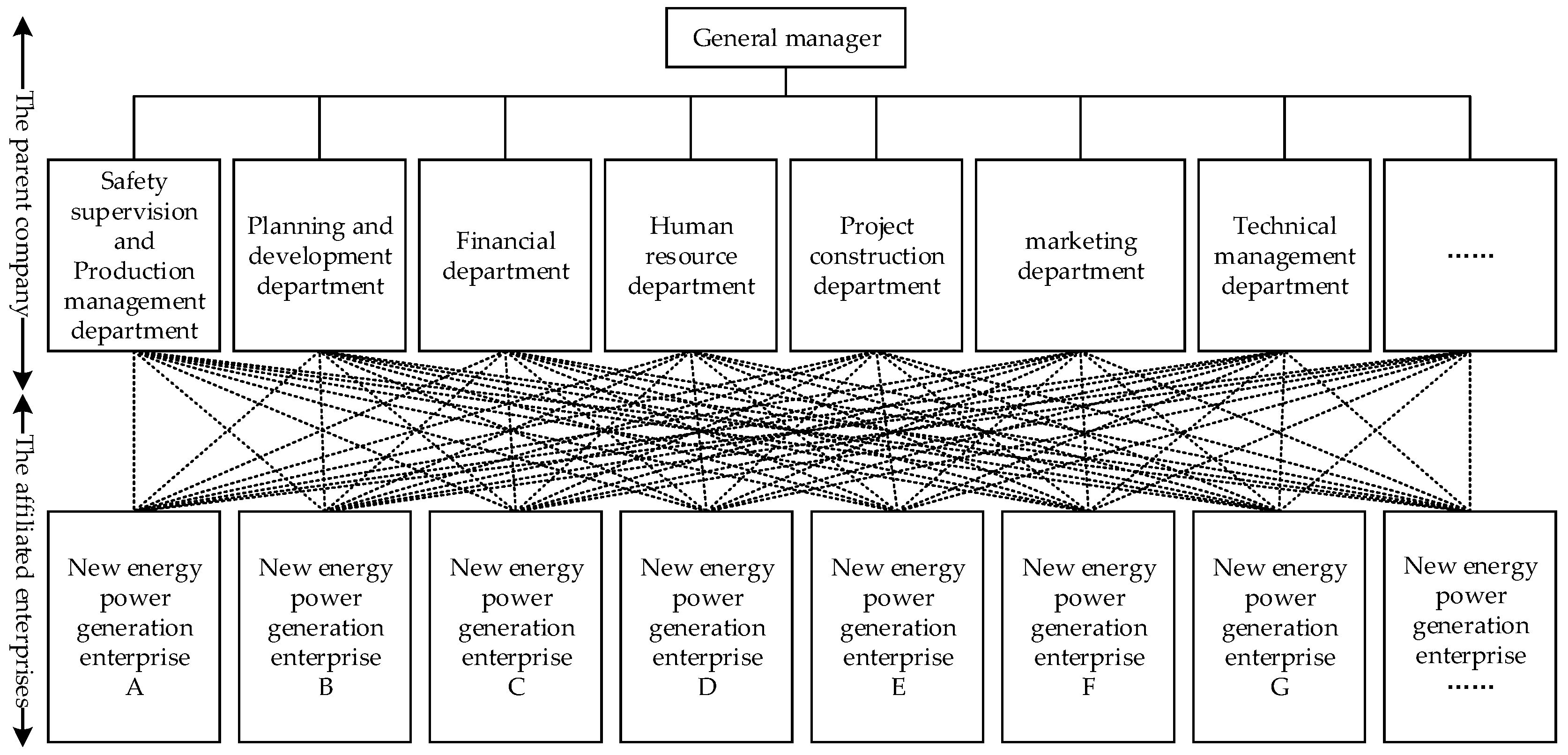
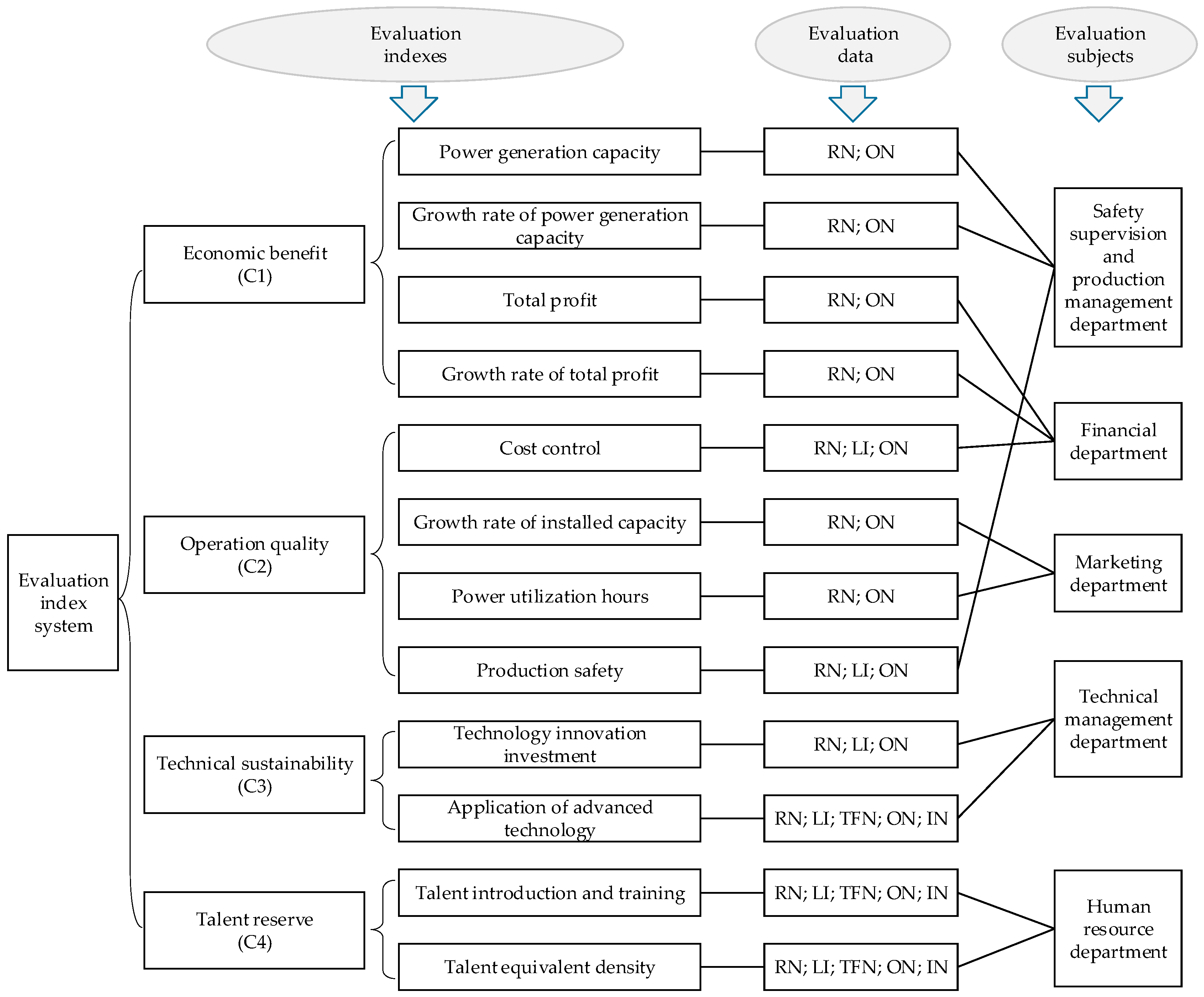
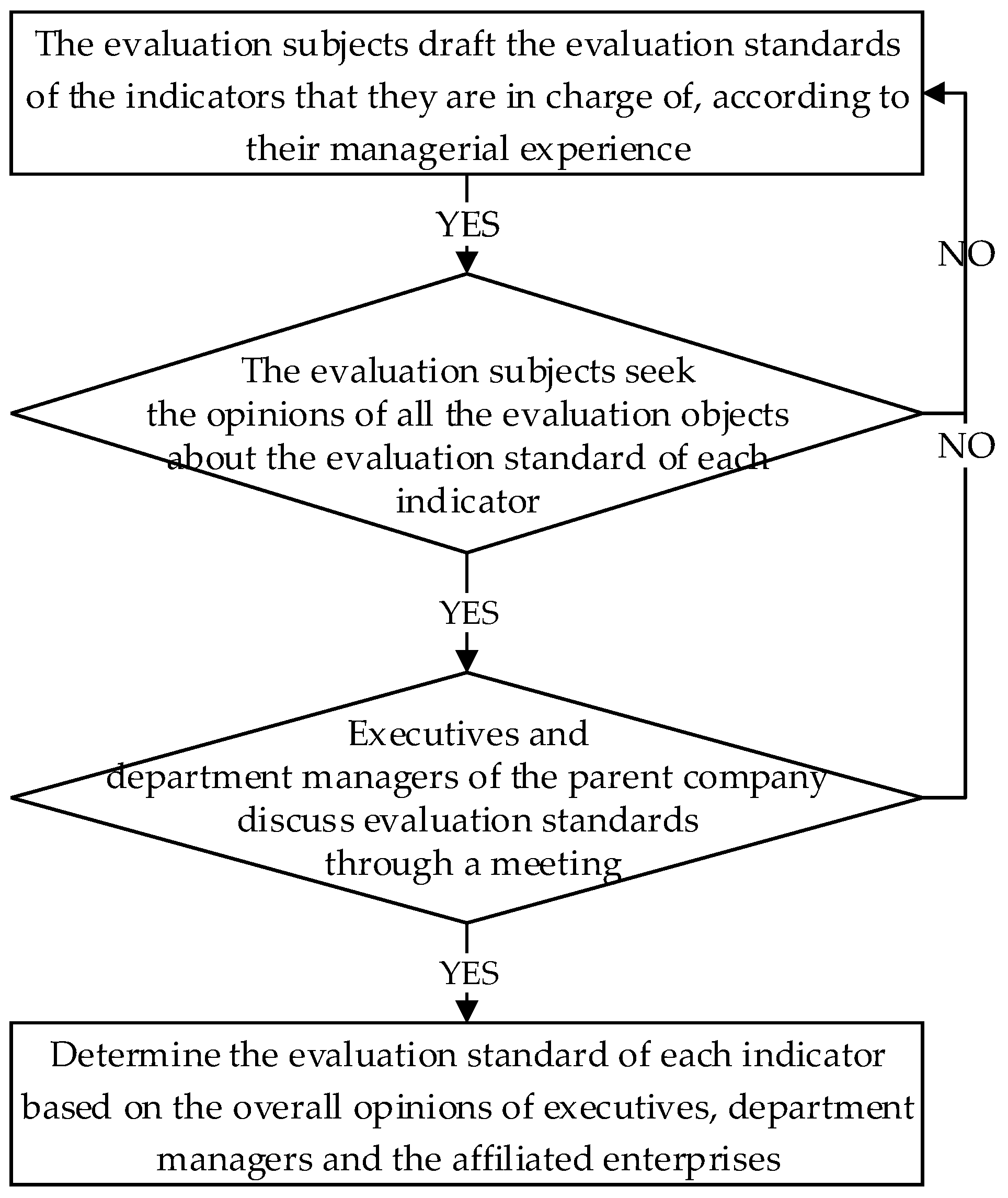
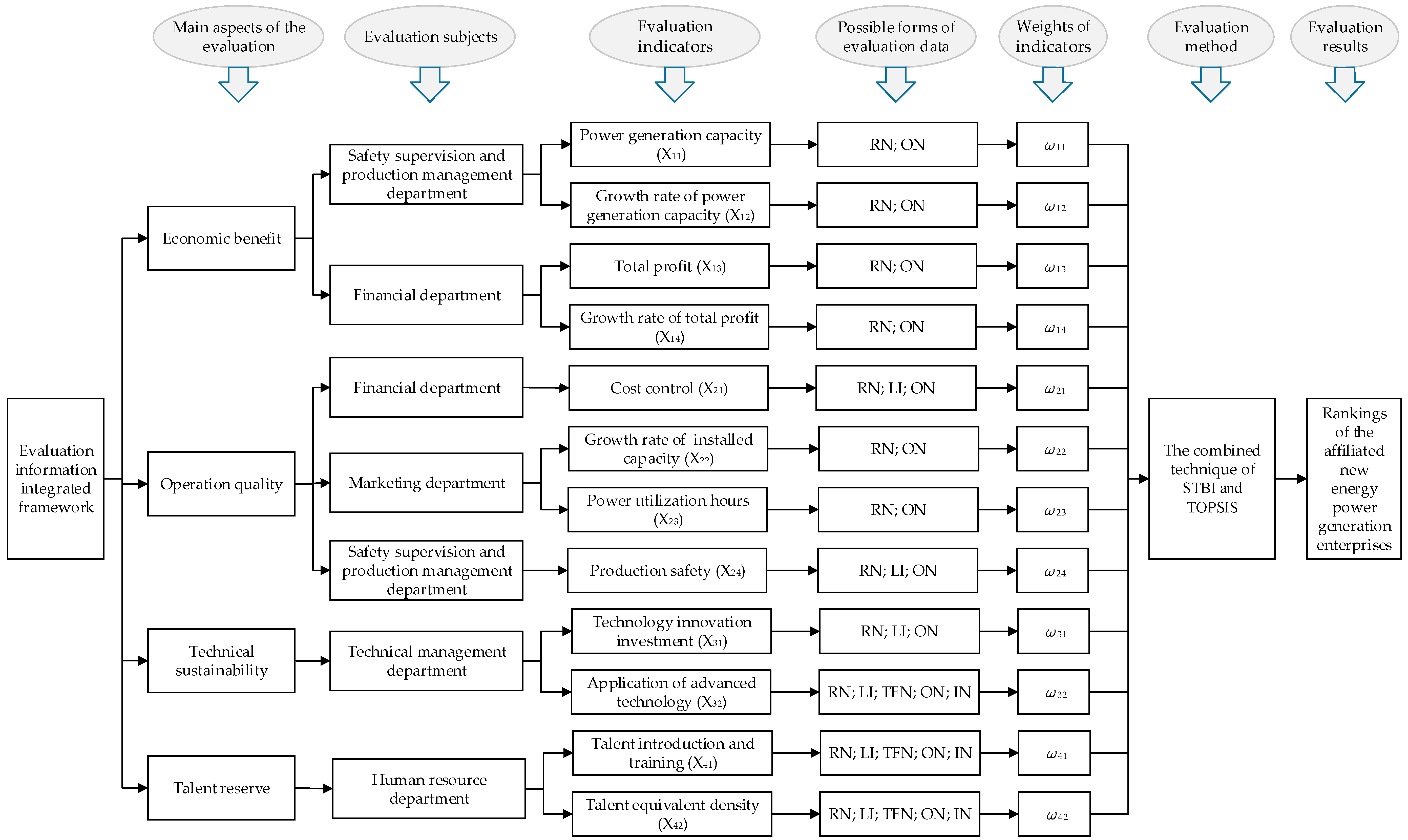

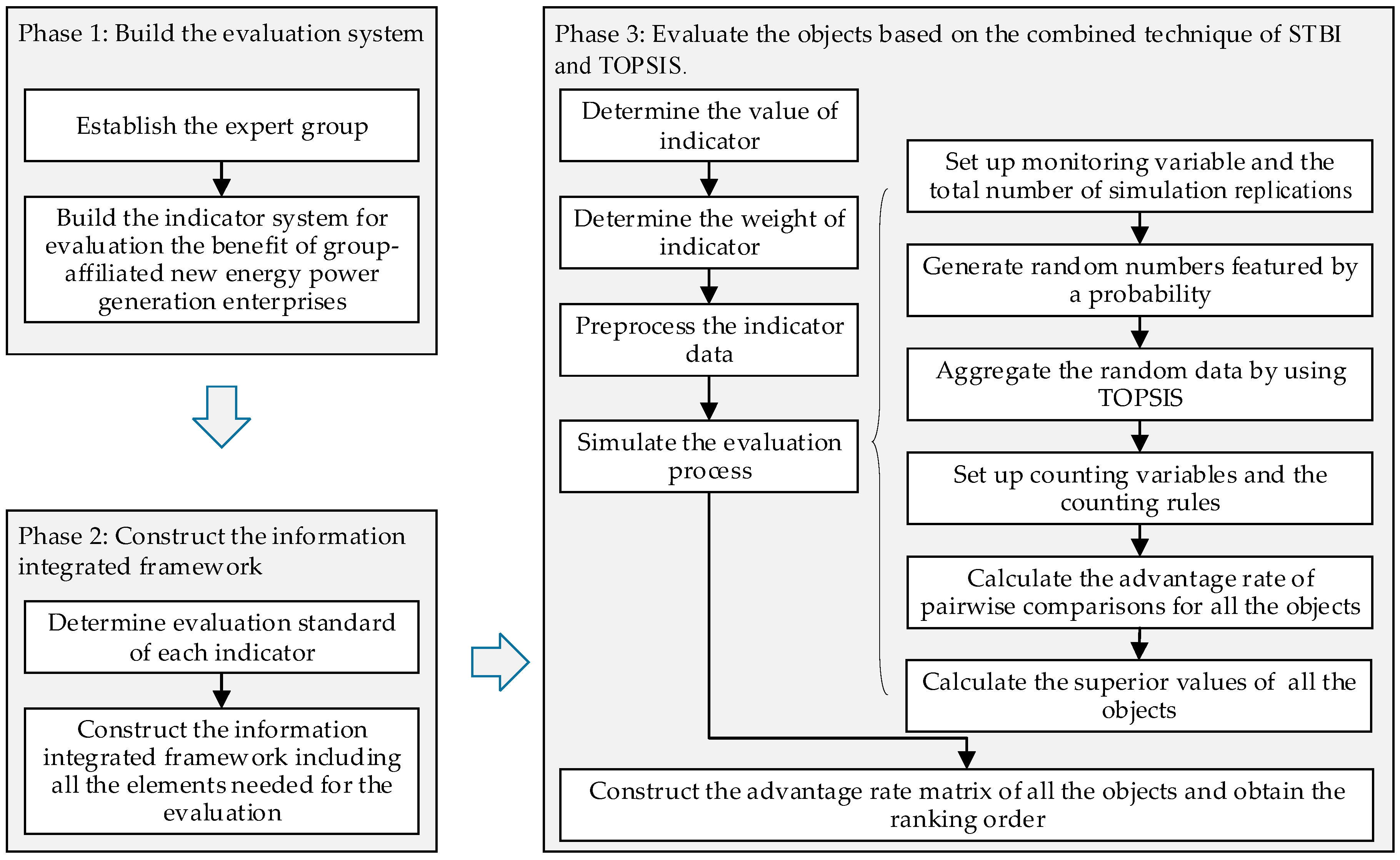
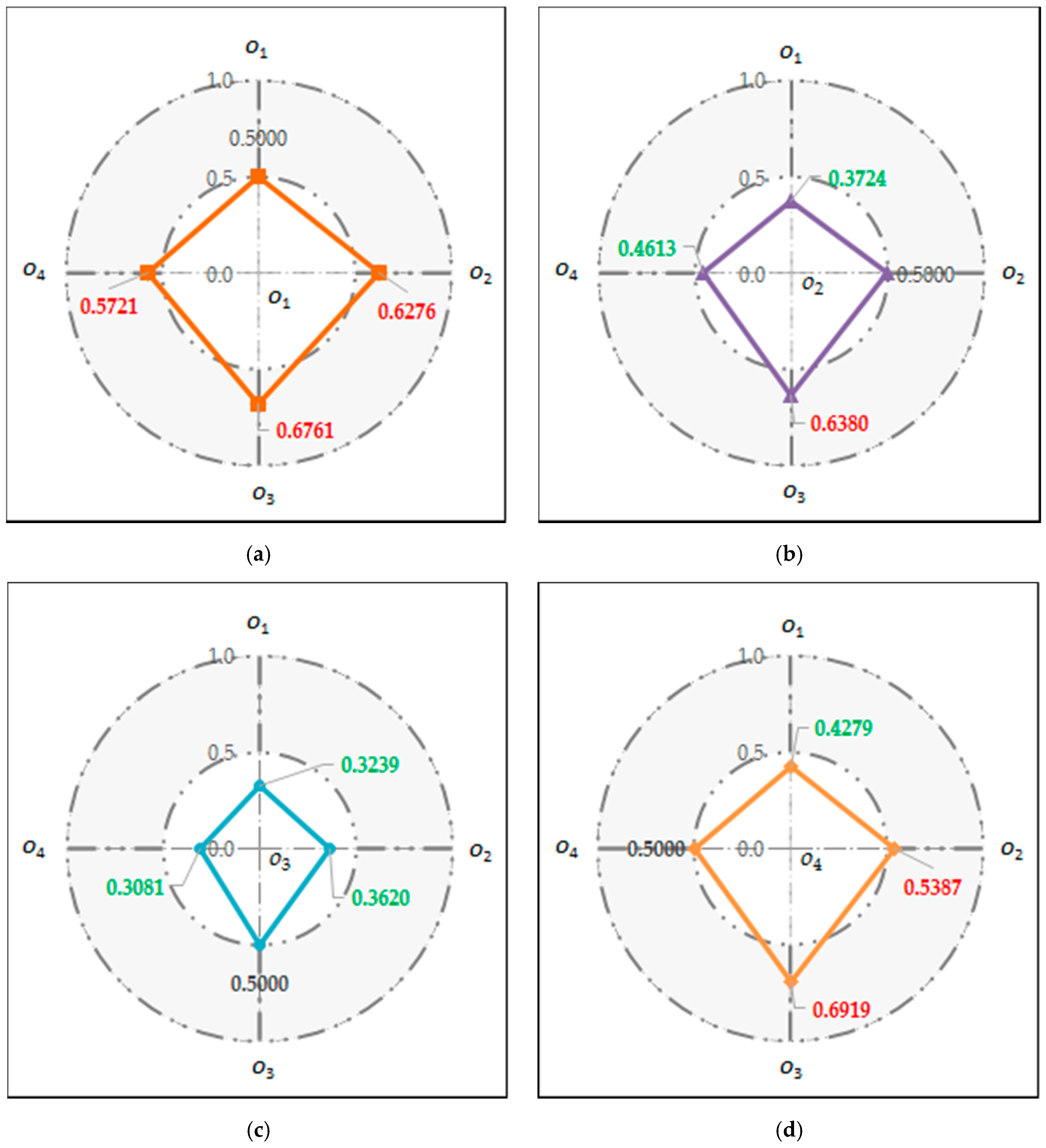
| Energy Type | Power Source Type | Cumulative Installed Capacity | Average Annual Growth | Growth Ranking | |
|---|---|---|---|---|---|
| 2010 | 2015 | ||||
| New energy | solar power | 0.80 | 43.18 | 122% | 1 |
| wind power | 29.58 | 130.75 | 34.6% | 2 | |
| biomass power | 5.50 | 10.30 | 13.4% | 4 | |
| Conventional energy | hydropower | 220 | 320 | 8.1% | 5 |
| coal-fired power | 660 | 900 | 6.4% | 6 | |
| gas power | 26.42 | 66.03 | 20.1% | 3 | |
| Notation | Linguistic Term | Corresponding TFN |
|---|---|---|
| S0 | Very poor | (0,0,0.25) |
| S1 | Poor | (0,0.25,0.5) |
| S2 | Fair | (0.25,0.5,0.75) |
| S3 | Good | (0.5,0.75,1) |
| S4 | Very good | (0.75,1,1) |
| Indicator Name | Data Type |
|---|---|
| Power generation capacity | RN |
| Growth rate of power generation capacity | RN |
| Total profit | RN |
| Growth rate of total profit | RN |
| Cost control | LI (T = 4) |
| Growth rate of installed capacity | RN |
| Power utilization hours | RN |
| Production safety | LI (T = 4) |
| Technology innovation investment | IN |
| Application of advanced technology | ON |
| Talent introduction and training | LI (T = 4) |
| Talent equivalent density | ON |
| Indicator Number | o1 | o2 | o3 | o4 |
|---|---|---|---|---|
| X11 | 4,284,749 | 2,572,317 | 1,764,391 | 2,686,241 |
| X12 | 36.70% | 18.30% | 5.10% | 26.40% |
| X13 | 1,118,425 | 701,685 | 408,791 | 798,666 |
| X14 | 38.30% | 17.20% | 1.10% | 31.40% |
| X21 | s3(T = 4) | s3(T = 4) | s2(T = 4) | s4(T = 4) |
| X22 | 0 | 3.20% | 5.20% | 0 |
| X23 | 1744 | 1934 | 1831 | 2570 |
| X24 | s4(T = 4) | s4(T = 4) | s3(T = 4) | s4(T = 4) |
| X31 | [78,85] | [82,89] | [74,83] | [79,86] |
| X32 | 1 | 2 | 4 | 3 |
| X41 | s4(T = 4) | s4(T = 4) | s3(T = 4) | s3(T = 4) |
| X42 | 3 | 1 | 2 | 4 |
| Indicator Number | Indicator Weight | Indicator Number | Indicator Weight |
|---|---|---|---|
| X11 | 0.1526 | X23 | 0.0717 |
| X12 | 0.0834 | X24 | 0.0709 |
| X13 | 0.1745 | X31 | 0.0698 |
| X14 | 0.0935 | X32 | 0.0623 |
| X21 | 0.1079 | X41 | 0.0523 |
| X22 | 0.0223 | X42 | 0.0388 |
© 2017 by the authors. Licensee MDPI, Basel, Switzerland. This article is an open access article distributed under the terms and conditions of the Creative Commons Attribution (CC BY) license (http://creativecommons.org/licenses/by/4.0/).
Share and Cite
Yang, W.; Liu, L.; Yu, X. Evaluating the Comprehensive Benefit of Group-Affiliated New Energy Power Generation Enterprises for Sustainability: Based on a Combined Technique of STBI and TOPSIS. Sustainability 2018, 10, 24. https://doi.org/10.3390/su10010024
Yang W, Liu L, Yu X. Evaluating the Comprehensive Benefit of Group-Affiliated New Energy Power Generation Enterprises for Sustainability: Based on a Combined Technique of STBI and TOPSIS. Sustainability. 2018; 10(1):24. https://doi.org/10.3390/su10010024
Chicago/Turabian StyleYang, Wenyin, Lin Liu, and Xiaobao Yu. 2018. "Evaluating the Comprehensive Benefit of Group-Affiliated New Energy Power Generation Enterprises for Sustainability: Based on a Combined Technique of STBI and TOPSIS" Sustainability 10, no. 1: 24. https://doi.org/10.3390/su10010024





